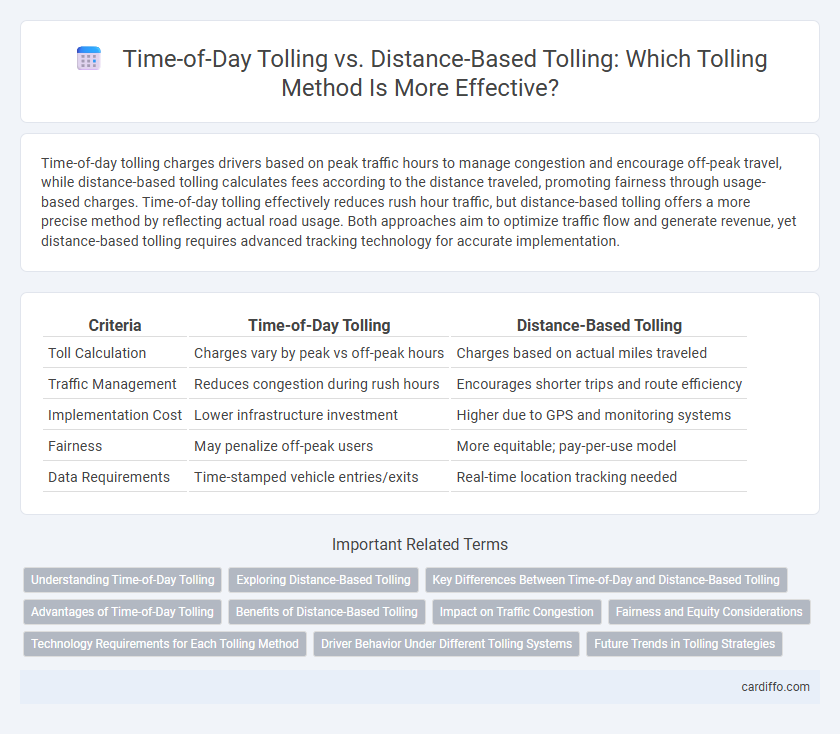Time-of-day tolling charges drivers based on peak traffic hours to manage congestion and encourage off-peak travel, while distance-based tolling calculates fees according to the distance traveled, promoting fairness through usage-based charges. Time-of-day tolling effectively reduces rush hour traffic, but distance-based tolling offers a more precise method by reflecting actual road usage. Both approaches aim to optimize traffic flow and generate revenue, yet distance-based tolling requires advanced tracking technology for accurate implementation.
Table of Comparison
| Criteria | Time-of-Day Tolling | Distance-Based Tolling |
|---|---|---|
| Toll Calculation | Charges vary by peak vs off-peak hours | Charges based on actual miles traveled |
| Traffic Management | Reduces congestion during rush hours | Encourages shorter trips and route efficiency |
| Implementation Cost | Lower infrastructure investment | Higher due to GPS and monitoring systems |
| Fairness | May penalize off-peak users | More equitable; pay-per-use model |
| Data Requirements | Time-stamped vehicle entries/exits | Real-time location tracking needed |
Understanding Time-of-Day Tolling
Time-of-Day Tolling charges drivers varying fees depending on the time they use a road, typically imposing higher rates during peak traffic hours to manage congestion effectively. This system encourages off-peak travel by providing economic incentives, helping reduce traffic volumes and emissions during busy periods. Implementing Time-of-Day Tolling requires advanced traffic monitoring technology and dynamic pricing algorithms to adjust toll rates in real-time based on congestion patterns.
Exploring Distance-Based Tolling
Distance-based tolling calculates fees based on the exact miles or kilometers traveled, offering a more precise and equitable approach compared to time-of-day tolling which charges based on travel periods. This system leverages GPS and advanced telematics to track vehicle movement, enabling dynamic pricing that reflects actual road usage and congestion levels. Implementing distance-based tolling can reduce traffic congestion, promote fairer road usage, and generate consistent revenue aligned with infrastructure wear and maintenance needs.
Key Differences Between Time-of-Day and Distance-Based Tolling
Time-of-day tolling charges drivers based on specific time periods, often targeting peak traffic hours to reduce congestion and manage road usage effectively. Distance-based tolling calculates fees according to the exact miles traveled on tolled roads, promoting fairness by correlating cost with actual road use. The key difference lies in pricing structure: time-of-day tolling emphasizes temporal demand management, while distance-based tolling focuses on usage-based equity and precise cost allocation.
Advantages of Time-of-Day Tolling
Time-of-day tolling effectively manages traffic congestion by adjusting rates during peak hours, encouraging drivers to travel during off-peak times and reducing overall road crowding. This method is simpler to implement and more predictable for commuters compared to distance-based tolling, as charges are tied to specific periods rather than variable mileage calculations. It also minimizes the need for extensive tracking technology, lowering operational costs and protecting driver privacy.
Benefits of Distance-Based Tolling
Distance-based tolling offers precise road usage charges by calculating fees according to the actual distance traveled, promoting equitable payment and encouraging fuel-efficient driving habits. It reduces congestion by distributing traffic more evenly across routes and times, leading to decreased travel delays and lower emissions. This system also provides reliable revenue streams for infrastructure maintenance and enhancements, supporting sustainable transportation planning.
Impact on Traffic Congestion
Time-of-Day Tolling effectively reduces traffic congestion by encouraging drivers to travel during off-peak hours, leading to a more balanced distribution of vehicles throughout the day. Distance-Based Tolling targets congestion by charging tolls based on the miles driven, promoting shorter trips and reducing overall vehicle miles traveled. Both systems aim to optimize traffic flow and decrease peak-hour congestion, but Time-of-Day Tolling directly influences travel timing while Distance-Based Tolling impacts travel distance.
Fairness and Equity Considerations
Time-of-day tolling charges drivers based on peak traffic periods, aiming to reduce congestion but may disproportionately impact low-income commuters with less flexible schedules. Distance-based tolling calculates fees according to miles traveled, promoting fairness by correlating costs directly with road usage and potentially distributing charges more equitably across all user demographics. Evaluating equity involves analyzing travel behavior patterns, income distribution, and access to alternative transportation when designing toll systems to ensure balanced financial burdens.
Technology Requirements for Each Tolling Method
Time-of-day tolling systems rely on advanced GPS and real-time traffic monitoring technology to adjust toll rates based on peak and off-peak hours, requiring robust data processing and communication infrastructure. Distance-based tolling demands precise vehicle tracking technologies, such as GPS or RFID, integrated with automated billing platforms to calculate charges accurately based on the miles traveled. Both methods necessitate secure data transmission, efficient server management, and reliable enforcement mechanisms to ensure compliance and minimize toll evasion.
Driver Behavior Under Different Tolling Systems
Time-of-day tolling influences driver behavior by encouraging travel during off-peak hours to avoid higher charges, often resulting in peak hour traffic reduction and smoother flow. Distance-based tolling motivates drivers to minimize travel distances and choose more efficient routes, potentially altering trip frequency and vehicle usage patterns. Both systems impact route choice, trip timing, and overall traffic congestion, but through distinct behavioral incentives linked to toll pricing structures.
Future Trends in Tolling Strategies
Time-of-day tolling adjusts charges based on peak and off-peak traffic periods to manage congestion, while distance-based tolling calculates fees according to the exact mileage traveled, offering precision in user charges. Future trends indicate a convergence of these models enhanced by real-time data analytics and GPS technology, enabling dynamic pricing that reflects current traffic conditions and road usage patterns. Integration with smart city infrastructure and autonomous vehicle networks will further optimize tolling strategies by promoting efficient traffic flow and reducing environmental impacts.
Time-of-Day Tolling vs Distance-Based Tolling Infographic

 cardiffo.com
cardiffo.com